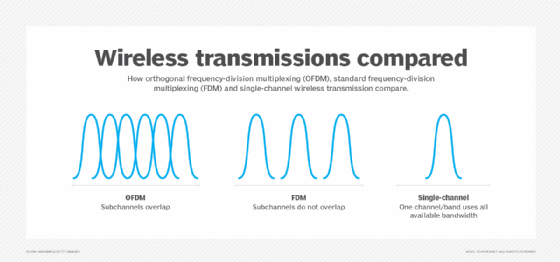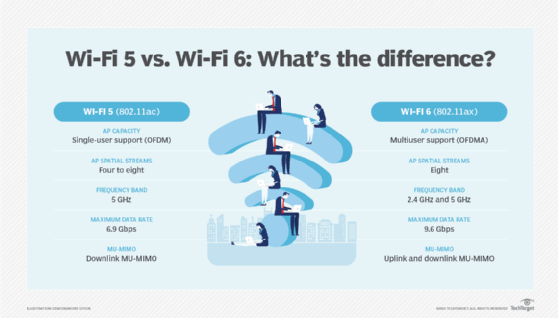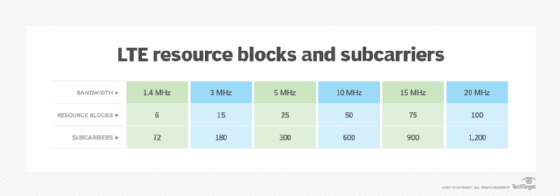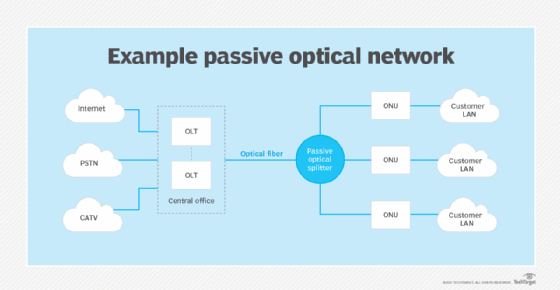subcarrier
What is a subcarrier?
A subcarrier is a secondary modulated signal frequency modulated into the main frequency (the carrier) to provide an additional channel of transmission. It allows for a single transmission to carry more than one separate signal. It is most commonly used in radio frequency (RF) transmissions but can be used in any modulated signal, such as in fiber optic transmissions.
A carrier frequency can be used to carry a signal with no subcarriers, a signal and some subcarriers, or only several subcarriers. Each subcarrier is used to carry additional information. The use of subcarriers allows the separate signals to all be received together as one transmission and then separated out by the receiver. It also allows for isolating the signals so only certain equipment receives specific channels.
To illustrate how carrier and subcarrier signals work, imagine a grandmother sending a letter to her grandchildren in an envelope. The letter is the signal that she wants to transmit. The envelope is the carrier frequency.
Putting the letter in the envelope is like mixing the signal and carrier for transmission. On the receiving side, the envelope is discarded and the letter can be read. This is like how the carrier frequency is subtracted from the received message and the signal is left.
To illustrate subcarriers, imagine she wanted to send separate letters to each child. So, she put each letter into a separate small envelope. These smaller envelopes are then put in a larger envelope that may also contain a main message on its own. In this case, signals -- the letters -- are mixed with lower frequency subcarriers, the envelopes.
The resulting signals are then mixed with the main carrier for transmission.
Subcarriers in radio transmission
Subcarrier signals are used in radio broadcasting for a number of purposes.
The main signal is a mono audio signal. A subcarrier contains the stereo audio. Additional subcarriers may contain small text messages, pager information or an additional low-fidelity audio channel.
FM stereo radio uses a subcarrier to produce a left and right audio channel. To maintain compatibility with simple mono radio, the left and right channels are added together and put on the main carrier frequency.
The difference between the left and right channel is that the right is put on a subcarrier of 38 kHz. This subcarrier is above the human hearing range and is not decoded by mono radios. A stereo radio will use the demodulated difference signal to reconstruct the left and right channel.
Most radio stations will have additional subcarriers for specific uses. A subcarrier at 57 kHz is used for small lines of text, such as the station or song name. Additional subcarriers at 67 kHz and 92 kHz can be used for audio broadcasts or text services. These audio services might be background music for stores or elevators (Muzak) or public service readings for the blind. Public data services might be used by pagers, traffic information or other data.
HD radio, or digital radio, in the U.S. uses orthogonal frequency-division multiplexing (OFDM) and additional bandwidth to add digital audio signals.

Subcarriers in television
Analog television uses subcarriers to carry color and audio information. In National Television Standards Committee (NTSC) television broadcasts, the color data is encoded on a subcarrier of about 3.58 MHz. This subcarrier frequency was chosen so that the color information would not conflict with the luminance channel on the main frequency.
The audio signal is encoded on a 4.5 MHz subcarrier. The individual color values and stereo audio are encoded as addition and subtraction signals, similar to stereo radio.
Some digital television standards may use subcarriers as OFDM, which is not used in the current U.S. digital television Advanced Television Systems Committee (ATSC) standard, but it is used in the future 4K/8K-capable ATSC 3.0 standard.
Subcarriers in Wi-Fi
All Wi-Fi standards use subcarriers as part of OFDM. In this use, there is no signal that is directly encoded on the carrier frequency. All signals -- or symbols as they are called in this context -- are first mixed with a subcarrier, which is then all mixed with the carrier frequency for transmission.
OFDM and subcarriers allow Wi-Fi to be more fault tolerant and carry data more reliably.
Older Wi-Fi standards, such as 802.11ab/g/n/ac, use 64 subcarriers. Each Wi-Fi channel is 20 MHz. Therefore, each subcarrier is spaced 312.5 kHz apart. Most of the subcarriers are used to transmit data. Others are used for synchronization pulses or guard space.

The latest Wi-Fi 6 standard, 802.11ax, uses more subcarriers and introduces orthogonal frequency-division multiple access (OFDMA). Wi-Fi 6 uses 265 different subcarriers spaced 78.125 kHz apart in the same amount of 20 MHz spectrum. It uses longer symbol time to increase the reliability of transmission to make up for the tighter subcarrier spacing.
OFDMA allows for specific groups of subcarriers, called resource units (RU), to be dedicated to different devices. For example, a Wi-Fi 6 router can dedicate eight subcarrier lanes to a tablet streaming video and the rest to a computer so they can both receive data at the same time. In contrast, older Wi-Fi can only send data to one device at a time, and each device will need to wait in turn to receive.
Subcarriers in cellphones, LTE 4G and 5G NR
Cellphone data uses subcarriers in OFDM and OFDMA arrangements to transmit data from the base station to the handset. In LTE, each subcarrier is spaced 15 kHz apart. These subcarriers are combined in groups of 12 to form a single resource block.
Each resource block is used in an OFDMA arrangement to send data to different handsets or combined for high-speed data. The total number of resource blocks and subcarriers on each channel in LTE can vary depending on the available bandwidth.

5G NR cellular data builds on OFDM and OFDMA and offers different levels of subcarrier spacing. The subcarriers can be spaced from 15 kHz to 240 kHz apart. In general, due to the characteristics of the channel bands, 15 kHZ to 60 kHz is used in carrier channels below 6 GHz, and 60 kHz to 120 kHz is used for higher frequency channels. In a maximum configuration, up to 3300 subcarriers are allowed on a single channel.
Subcarriers in fiber optics
Fiber optic data transmission can use subcarrier multiplexing (SCM) to transmit multiple channels of data at a single wavelength or light.

This is used in passive optical network (PON), where the receivers can be set to only receive a specific subcarrier. This way, one sending light source can transmit different data to several different receivers all connected to the same optical pathway.








